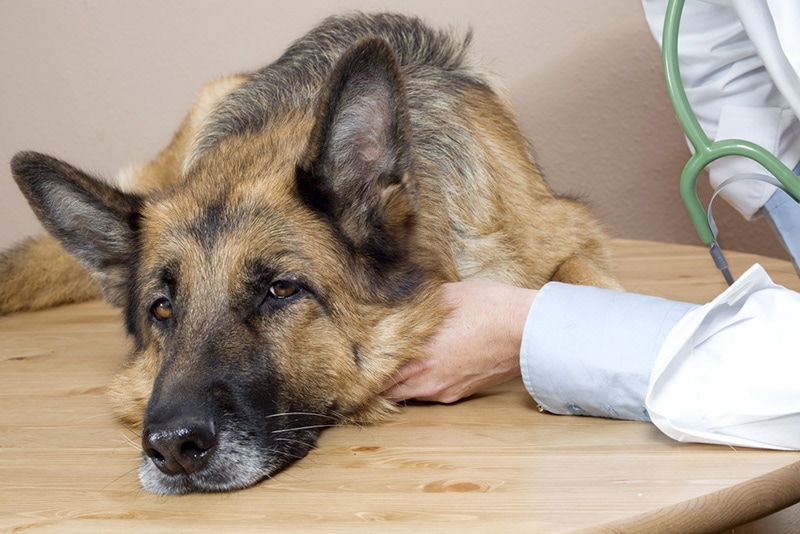Click to Skip Ahead
It’s heartbreaking to watch your pet endure a fever. Like humans, dogs experience a fever when their body temperature is higher than normal. A healthy dog should have a temperature of around 101–102.5°F, whereas a fevered dog may experience temperature fluctuations much higher than the norm.
In this article, we will review the signs of fever and some potential causes in dogs. We will also discuss how to take your dog’s temperature and soothe your poor pup. To learn more about caring for your fevered dog, keep reading below.
Disclaimer: If your dog is suffering from a fever or is unwell in any way, it’s important to speak to your vet promptly rather than to self-diagnose. There are many potential causes of fever, and all of them require veterinary attention, while some may be an indicator of a more serious health issue. The sooner your dog receives a diagnosis and appropriate treatment, the better their chances of recovery. The information in this article has been reviewed by a vet but cannot cover the vast multitude of causes of fever in dogs. This article is intended to provide useful information but is not a substitute for a thorough clinical examination performed by a veterinarian.
Signs of Fever
Other than an abnormally high body temperature, several signs may indicate that your dog is suffering from a fever. Some of the most common signs include:
- Lethargy or weakness
- Redness of the eyes
- Warm ears and a warm, dry nose (not a reliable indicator)
- Red gums
- Lack of appetite
- Breathing fast or panting
- Shivering
- Reluctance to move and walk
- Discomfort
A dog’s body temperature may also change due to strenuous exercise, outside air temperature, and excessive excitement, but these fluctuations tend to be subtle and resolve themselves fairly quickly. Therefore, looking for these other signs is critical when trying to detect a fever. However, the best way to confirm whether or not your dog has a fever (as well as why they have one) is to take them to the vet. Depending on the root cause, cases of fever are accompanied by gastrointestinal signs, urinary issues, breathing changes, coughing, neck pain, limping, or others.

The 7 Causes of Fever & Common Examples
There are several reasons why your dog may have a fever, and not all of them are clear-cut. But for the most part, canine fevers fall into one of these categories: inflammation, infection, immune-mediated, and cancer-related. Sometimes, the cause of a fever may be impossible to determine.
1. Vaccinations
Vaccinations are essential to your dog’s well-being, as they boost the immunity against diseases that may threaten their health. While they are vital to your dog’s long-term health, they can cause some minor short-term side effects. A fever is among them since anything that activates the immune system has the potential to lead to a fever. Other medications can also lead to adverse reactions and fever.
- Mild redness and swelling of the injection site
- Fatigue
- Decrease in appetite
- Nasal discharge, coughing, or sneezing (in case of a kennel cough vaccine)
- Anaphylaxis (rare)
The fever from vaccinations tends to be inconsequential and short and rarely ever requires veterinary treatment. Still, if your dog appears uncomfortable or the side effects last longer than 24 hours, reach out to your vet. On the other hand, anaphylaxis requires emergency veterinary attention and may manifest as swelling on the face, hives, breathing difficulties, vomiting, diarrhea, and others.

2. Inflammatory Conditions
Inflammation is the body’s normal response to insult, such as trauma, injury, or irritation. Oftentimes, the cause may be difficult to pinpoint. Inflammation may occur without an infection. One of the most common inflammatory conditions in dogs is pancreatitis.
Pancreatitis is the inflammation of the pancreas, which is responsible for creating digestive enzymes used to break down food. This inflammation is due to an early activation of the digestive enzymes, causing the pancreas to digest itself. It manifests as lethargy, abdominal pain, vomiting, reduced appetite, diarrhea, weight loss, and in acute cases, collapse and even shock.
Another example of an inflammatory disease is a syndrome called Inflammatory bowel disease, which is a large group of conditions triggered by various factors, such as parasites, bacterial infections, and disbalance in the normal gut bacteria population, and it may also be immune-mediated.
3. Immune-Mediated Conditions
Autoimmune or immune-mediated diseases are closely linked to the immune system, and a flare-up may lead to a fever. Autoimmune diseases prevent your dog’s immune system from distinguishing between foreign bodies and the regular, healthy cells within your dog’s body. This causes the immune system to attack itself, causing damage to the body.
In some cases, the underlying cause may involve an infection, toxin, or even cancer that has stimulated the immune system into destroying its own cells. However, in many cases, the cause may remain unknown. Some breeds and age groups may be predisposed to certain immune-mediated conditions.
- Immune-mediated hemolytic anemia – destruction of red blood cells, causing anemia
- Immune-mediated thrombocytopenia – destruction of platelets, causing clotting issues
- Immune-mediated polyarthritis – joint inflammation, causing pain and limping
- Meningoencephalitis – inflammation of the brain and meninges, causing neck pain
- Reduced appetite
- Lethargy and weakness
- Collapse
- Pale or jaundiced gums
- Clotting issues, bruising
- Blood in urine or feces
- Limping
- Joint pain and swelling
- Stiff and painful neck
- Vomiting
- Diarrhea
The large variety of conditions and signs associated with immune-mediated illnesses shows how important it is to contact your vet if you suspect your dog has a fever. They will be able to diagnose if your dog is suffering from an immune-mediated or other condition.
4. Bacterial, Fungal, Protozoal, or Viral Infections
Infections of all sorts can lead to fever in your dog. Whether the infection is bacterial, fungal, protozoal, or viral, it can stimulate an immune response and lead to a fever. Protozoa are single-celled parasitic organisms that can be transmitted by tick bites and cause damage to the blood cells or be ingested, leading to gastrointestinal signs. Some of the causes of fever in dogs may include infections such as Leptospirosis, Brucellosis, Parvovirosis, and Distemper.
Signs of infection in dogs may vary depending on the specific culprit and affected organs or tissues. You can expect to see lethargy, sneezing, coughing, or other breathing problems if the respiratory tract is affected, or urinary issues if the kidneys or bladder are affected. Gastrointestinal infections (and parasite infestations) cause vomiting, reduced appetite, painful abdomen, and diarrhea. Infections of the skin and ears or wounds can also lead to fever, alongside redness and swelling, itching, and discharge from the skin or inside the ears.

5. Sepsis
Sepsis may occur when the body is reacting to an infection. It is an extreme reaction that can lead to inflammation throughout the entire body and even cause organs to shut down. This condition can quickly become life-threatening.
- Lethargy
- Vomiting
- Diarrhea
- Loss of appetite
- Disorientation or confusion
- Rapid heart rate or breathing
- Low blood pressure
If you suspect that your dog has sepsis, contact your vet immediately; it is a medical emergency.

6. Ingestion of Toxins
Dogs seem to love to get into things they shouldn’t. At best, this causes a minor tummy ache. At worst, it can lead to a toxic reaction. There are several things dogs should never eat, including alcohol, chocolate, and onions. If your dog is experiencing a fever or has eaten something they shouldn’t have, immediately reach out to your vet or local emergency clinic. If possible, bring the label of the ingested item with you so that your vet can evaluate the severity of the problem.
7. Cancer
The most concerning diagnosis any dog may get is cancer. This is the word we are all dreading. There are many types of cancer in dogs; some are benign and can be resolved with surgery or even monitored by your vet, while others are malignant, requiring a combination of surgery and chemotherapy. Some cancers may be too far gone by the time a diagnosis is reached.
Cancer can cause cell and tissue destruction, which may in turn lead to fever. It can affect any tissue or organ system, including the skin, digestive, urinary, respiratory tract, bones, muscles, and others. Your vet will be able to confirm which type of cancer it is by performing X-rays, scans, and biopsies, and will recommend the best treatment or management option for it.
How to Soothe Your Dog’s Fever
To help your dog battle a fever, your vet will prescribe appropriate medication depending on the cause and may hospitalize your dog for intravenous fluids and painkillers. They will also instruct you on how to care for your dog when they’re ready to be discharged from the clinic and when they should come back for a check.
How to Take Your Dog’s Temperature
Taking your dog’s body temperature is the best way to detect a fever. Two instruments can be used to measure your dog’s internal temperature: a digital ear thermometer or a digital rectal thermometer. Older mercury thermometers are no longer considered safe or appropriate for usage.
Ear thermometers are the least invasive (and probably less daunting) of the two options. You will gently insert the ear thermometer into your dog’s horizontal ear canal. However, if not inserted properly, which can be tricky and will depend on the length of the ear canal and the dog’s tolerance, the measurement may be inaccurate.
Rectal thermometers are considered the gold standard for measuring a dog’s temperature, though many people may find them less appealing for obvious reasons. If you use a rectal thermometer, lubricate it with baby oil or petroleum jelly. Wait until the thermometer beeps for an accurate reading.
No matter which thermometer you choose to use, make sure that you follow the instructions carefully, to avoid injuring your dog or getting an incorrect reading.

When to Take Your Dog to the Vet
When your dog’s temperature hits 103°F or higher, take them to the vet. Temperatures over 106°F can damage their organs, leading to fatal consequences. It is better to go early and be safe rather than sorry.
Conclusion
No one likes to see their dog suffer from a fever. Regardless of the cause of the fever, watching our pets endure sickness is a difficult matter. We hope this article has helped you spot the signs of fever and learn more about the potential causes. If you believe your dog is battling a fever, do not delay getting them the veterinary treatment they need. The sooner they are healed, the sooner they can return to their tail-wagging self!
Related read:
Featured Image Credit: Pressmaster, Shutterstock
Image Credit: Krysja, Shutterstock













